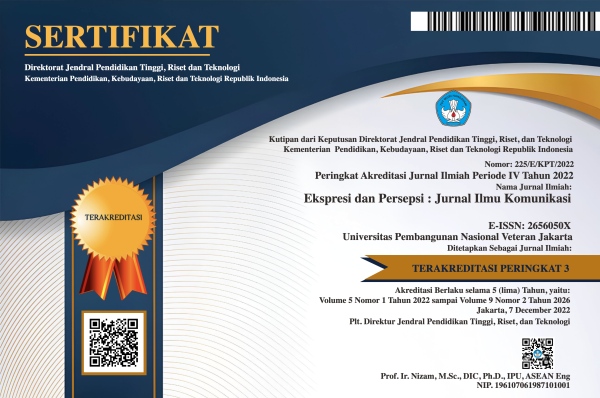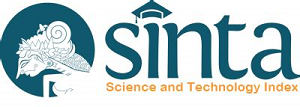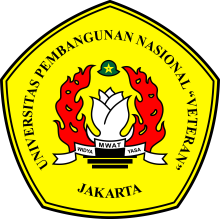Critical Discourse on Prejudice and Stereotypes of Women in the Short Film "Kos-kosan"
DOI:
https://doi.org/10.33822/jep.v7i2.7236Keywords:
Mills’s critical discourse analysis, misunderstanding, prejudice, short film, stereotypesAbstract
Visual media is a very popular communication media in society, with short films being particularly accessible and easily interpreted by viewers. This research aims to analyse a short film titled "Kos - Kosan", which address the issue of prejudice and stereotypes related to religious conflict, focusing on the subject-object position, author-reader positions depicted in the scenes shown. Using Sara Mills' Critical Discourse Analysis and a descriptive qualitative analysis method, this study seeks to describe the impact on women and explore the perspective and actions taken by viewers of the short film plot towards the object, women. This study found that the conflict that occurs is primarily due to misunderstandings in communication, where the subject directs the object toward an understanding that negative connotation. Similarly, viewers tend to perceive women in terms of immorality and promiscuity rather than discrimination and intolerance. One of the factors causing misunderstandings in communication between the actors of this short film is nonverbal communication, including facial expressions and body language, which often lead to misinterpretation.
References
Adman. (2004). Komunikasi Efektif dalam Tim. MANAJERIAL, 2(4), 70–77. https://doi.org/https://doi.org/10.17509/manajerial.v3i1.16486
Akihary, S., Marta, R. F., & Panggabean, H. (2023). Media Framing of Identity Politics through Prejudice and Stereotype Towards the 2024 Election. Jurnal Kajian Jurnalisme, 7(1), 14–26. https://doi.org/10.24198/jkj.v7i1.46191
Alawiyah, S., Rahman, I. K., & Handrianto, B. (2020). Meningkatkan Kesadaran Menutup Aurat Melalui Pendekatan Konseling REBT Islami. Islamic Religion Teaching & Learning Journal, vol.5(no.2), 225–239. https://doi.org/https://doi.org/10.15575/ath.v5i2.9532
Asheva, A. J., & Tasyarasita, A. Z. (2022). Case of Vengeful Woman in News Text: Sara Mills’ Critical Discourse Analysis. Deiksis, 14(2), 142–149. https://doi.org/10.30998/deiksis.v14i2.9999
Ayu, M. A., & Anggraini, D. K. (2023). Film Aquaman Sebagai Media Kampanye Kesadaran Lingkungan Global. Jurnal Netnografi Komunikasi, 2(1), 19–26. https://doi.org/https://doi.org/10.59408/netnografi.v2i1.15
Edwards, R., Bybee, B. T., Frost, J. K., Harvey, A. J., & Navarro, M. (2017). That’s Not What I Meant: How Misunderstanding Is Related to Channel and Perspective-Taking. Journal of Language and Social Psychology, 36(2), 188–210. https://doi.org/10.1177/0261927X16662968
Fadli, M. R. (2021). Memahami desain metode penelitian kualitatif. Humanika, Kajian Ilmiah Mata Kuliah Umum, 21(1), 33–54. https://doi.org/10.21831/hum.v21i1
Fatma, D., & Isnarmi, I. (2020). Kontrol Sosial Masyarakat Terhadap Perilaku Mahasiswa Kos-Kosan Air Tawar Barat Padang. Journal of Civic Education, 3(3), 257–266. https://doi.org/https://doi.org/10.24036/jce.v3i3.380
Fianto, L., & Qorib, F. (2022). Komodifikasi Agama dan Kepentingan Ekonomi Politik Media dalam Sinetron Para Pencari Tuhan. Jurnal Komunikasi Nusantara, 4(1), 140–148. https://doi.org/10.33366/jkn.v4i1.148
Gonda, S. M., Bahfiarti, T., & Farid, M. (2023). Implementasi Komunikasi Organisasi Berbasis Kearifan Lokal dalam Pelayanan Publik. Ekspresi Dan Persepsi : Jurnal Ilmu Komunikasi, 6(3), 518–534. https://doi.org/10.33822/jep.v6i3.6391
Gora, R., Muqsith, M. A., & Hossain, B. (2022). Media Construction of Erick Thohir in Determining the Commissioners of State-Owned Enterprises (BUMN). Ekspresi Dan Persepsi : Jurnal Ilmu Komunikasi, 5(2), 214–223. https://doi.org/10.33822/jep.v5i2.3850
Sulistio, H. P., Rasyid, Y., & Anwar, M. (2022). Penggambaran Kekerasan dalam Rumah Tangga (KDRT) pada Surat Kabar Daring: Analisis Wacana Kritis Model Sarah Mills. Lingua Rima: Jurnal Pendidikan Bahasa Dan Sastra Indonesia, 11(3), 133–142. https://doi.org/http://dx.doi.org/10.31000/lgrm.v11i3.7290
Hartono, R. D., & Gianawati, N. D. (2013). Faktor-Faktor Yang Menyebabkan Remaja Berperilaku Menyimpang (The Factors That Causes Teenagers Behave Deviant). Artikel Ilmiah Penelitian Mahasiswa, 1–4. http://repository.unej.ac.id/bitstream/handle/123456789/58735/Rizki
Hasan, I., Bahtiar, & Peribadi. (2022). Perilaku Menyimpang mahasiswa di Rumah Kost. SOCIETAL: Jurnal Pemikiran Dan Penelitian Sosiologi, 9(1), 100–109. https://garuda.kemdikbud.go.id/documents/detail/3130354
Kurniawan, E. (2023). Masyarakat Istimewa dalam Film-Film Pendek Paniradya Kaistimewan Yogyakarta. Bandar Maulana Jurnal Sejarah Kebudayaan, 28(2), 53–68. https://e-journal.usd.ac.id/index.php/BandarMaulana
Kurniawati, L. S. M. W., & Marta, R. F. (2021). Menelisik Sejarah Gudeg Sebagai Alternatif Wisata dan Citra Kota Yogyakarta. Sejarah Dan Budaya; Jurnal Sejarah, Budaya, Dan Pengajarannya, 15(1), 26–35. https://doi.org/10.17977/um020v15i12021p26
Lenardi, C., Jerfui, E., & Marta, R. F. (2020). Unity Value Representation in Halodoc’s Ad #diRumahAja: A Cultural Dimension Study. JURNAL ASPIKOM JATIM, 1(1), 71–84. https://jurnalaspikomjatim.org/index.php/redaksi/article/view/33
Marta, R. F., & Rieuwpassa, J. S. (2018). Identifikasi Nilai Kemajemukan Indonesia sebagai Identitas Bangsa dalam Iklan Mixagrip Versi Keragaman Budaya. Jurnal Kajian Komunikasi, 6(1), 37–50. https://doi.org/https://dx.doi.org/10.24198/jkk.v6i1.15416
Marta, R. F., & Robin, P. (2019). Kebahasaan Sinematik Bernuansa Pluralitas dalam Iklan BNI Taplus Anak. Communication, 10(1), 16–37. https://doi.org/https://dx.doi.org/10.36080/comm.v10i1.810
Mella, P. (2022). In every organization, gender stereotypes reduce organizational efficiency and waste productive energy: a systems thinking perspective. Kybernetes, 51(13), 156–185. https://doi.org/10.1108/K-04-2021-0283
Micevski, M., Diamantopoulos, A., & Erdbrügger, J. (2021). From country stereotypes to country emotions to intentions to visit a country: implications for a country as a destination brand. Journal of Product and Brand Management, 30(1), 118–131. https://doi.org/10.1108/JPBM-09-2019-2563
Monica, N., Farady Marta, R., & Panggabean, H. (2023). Studi Efikasi Diri terhadap Komunikasi Non-Verbal dalam Karakter Utama Film The Pursuit of Happiness. SCRIPTURA, vol.13(no.1), 79–89. https://doi.org/10.9744/scriptura.13.1.79-78
Muntoni, F., Wagner, J., & Retelsdorf, J. (2021). Beware of Stereotypes: Are Classmates’ Stereotypes Associated With Students’ Reading Outcomes? Child Development, 92(1), 189–204. https://doi.org/10.1111/cdev.13359
Muryana. (2017). Kebebasan Ekspresi Keagamaan di Jogja City of Tolerance (Studi Kasus Toleransi dan Intoleransi di Balik Plank “Terima Kost Putra Muslim/Putri Muslimah”). Religi: Jurnal Studi Agama-Agama, 13(1), 1–20. https://doi.org/https://doi.org/10.14421/rejusta.2017.1301-01
Novianti, N., Musa, D. T., & Darmawan, D. R. (2022). Analisis Wacana Kritis Sara Mills Tentang Stereotipe Terhadap Perempuan dengan Profesi Ibu Rumah Tangga dalam Film Rumput Tetangga. Rekam: Jurnal Fotografi Televisi Animasi, 18(1), 25–36. https://doi.org/https://doi.org/10.24821/rekam.v18i1.6893
Nugroho, M. A. B., & Rakhman, Y. (2022). Terjemahan Analisis Ujaran Seksisme dan Pelecehan Seksual dalam Subtitle Bahasa Idonesia di Dalam Film Berjudul Red Sparrow. Fon: Jurnal Pendidikan Bahasa Dan Sastra Indonesia, 18(1), 26–35. https://doi.org/10.25134/fon.v18i1.4497
Permana, R. S. M., & Alam, P. W. (2022). Ekonomi Politik Media dalam Perspektif Komunikasi dan Sosial-Budaya. Jurnal Kajian Budaya Dan Humaniora, 4(2), 238–243. https://doi.org/https://dx.doi.org/10.61296/jkbh.v4i2.19
Rachmaria, L., & Susanto, A. (2024). Potential for Online-Based Gender Violence in the Misuse of Artificial Intelligence Technology for Women in Social Media. Jurnal Netnografi Komunikasi, 2(2), 91–104. https://doi.org/https://doi.org/10.59408/jnk.v2i2.25
Rafiqa, S. (2019). Critical Discourse Analysis Sara Mils in the Online News Text about the Sinking of Ships at Indonesian Waters. Hortatori : Jurnal Pendidikan Bahasa Dan Sastra Indonesia, 3(1), 37–43. https://doi.org/10.30998/jh.v3i1.87
Rakhmania, R., Marta, R. F., Panggabean, H., & Wang, C. (2023). Kartini From Alor: Emerging the Discourse of Teacher’s Professional Identity in Kick Andy and Kumparan. Al-Balagh : Jurnal Dakwah Dan Komunikasi, 8(1), 105–140. https://doi.org/10.22515/albalagh.v8i1.6438
Sariasih, W., Rasyid, Y., & Anwar, M. (2023). Analisis Wacana Kritis Sara Mills dalam Cerpen Sepasang Mata Dinaya yang Terpenjara. Diglosia: Jurnal Kajian Bahasa, Sastra, Dan Pengajarannya, 6(2), 539–548. https://doi.org/10.30872/diglosia.v6i2.607
Sarwono, R. B. (2019). Menelisik Dorongan Agresi Para Pelajar Pelaku “Klithih” di Yogyakarta. Jurnal of Counseling and Personal Development, 1(1), 58–70. https://e-journal.usd.ac.id/index.php/solution/article/view/2260
Sya, M., Farady Marta, R., & Hadi, I. P. (2020). Refleksi Pluralisme Melalui Film Animasi Si Entong Sebagai Identitas Budaya Indonesia. JURKOM; Jurnal Riset Komunikasi, 3(1), 18–33. https://doi.org/https://doi.org/10.24329/jurkom.v3i1.102
Venus, A., & Waluyo, L. S. (2020). Komunikasi Konflik Jawara Banten. 3(1), 58–61. https://doi.org/https://doi.org/10.33822/jep.v3i1.1520
Wirahmat, H., & Alfiyani, N. (2022). Perempuan di antara Agama dan Budaya. SPECTRUM: Journal of Gender and Children Studies, 2(1), 57–74. https://doi.org/https://doi.org/10.30984/spectrum.v2i1.400
Yohana, A., & Saifulloh, M. (2019). Interaksi Simbolik dalam Membangun Komunikasi. WACANA: Jurnal Ilmiah Ilmu Komunikasi, 18(1), 122–130. https://doi.org/http://dx.doi.org/10.32509/wacana.v18i1.720
Yulisinta, F., Marta, R. F., Panggabean, H., Wang, C., & Gatcho, A. R. G. (2023). The discursive construction of spiritual values and cultural standards in Sang Pemimpi Film. International Journal of Visual and Performing Arts, 5(1), 18–33. https://doi.org/10.31763/viperarts.v5i1.972
Yusuf, Saleh, F., Yusuf, R., Haeruddin, & Fitrahmahyudi. (2022). Pappasang Sebagai Media Edukatif Pencegahan Pergaulan Bebas Bagi Anak-Anak Berbasis Ajaran Islam. IDIOMATIK: Jurnal Pendidikan Bahasa Dan Sastra Indonesia, 5(1), 43–54. https://doi.org/https://dx.doi.org/10.46918/idiomatik.v5i1.1415
Zuwirna. (2016). Komunikasi yang Efektif. E-TECH; Jurnal Ilmiah Teknologi Pendidikan, 6(1), 1–8. https://doi.org/https://doi.org/10.24036/et.v2i1.10464
Downloads
Published
Issue
Section
License
Copyright (c) 2024 Serilio Verdial Maria Borges, Rustono Farady Marta, Hana Rochani Gustasari Panggabean, Rizki Briandana, Maichel Chinmi

This work is licensed under a Creative Commons Attribution-NonCommercial 4.0 International License.














